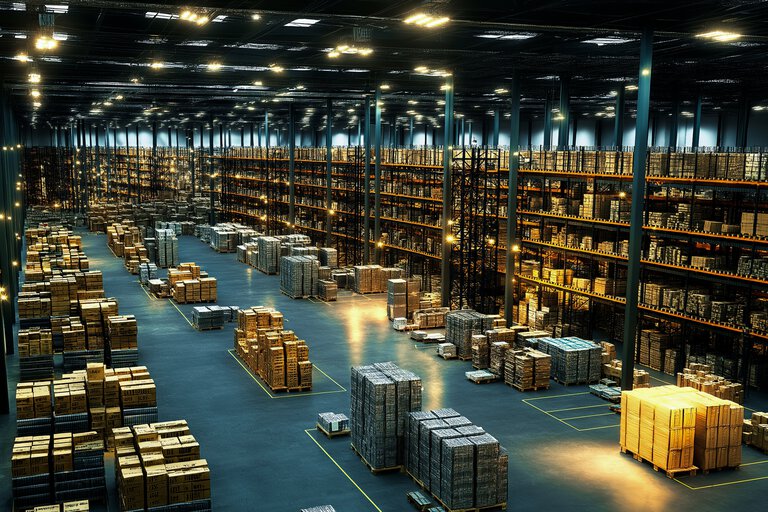
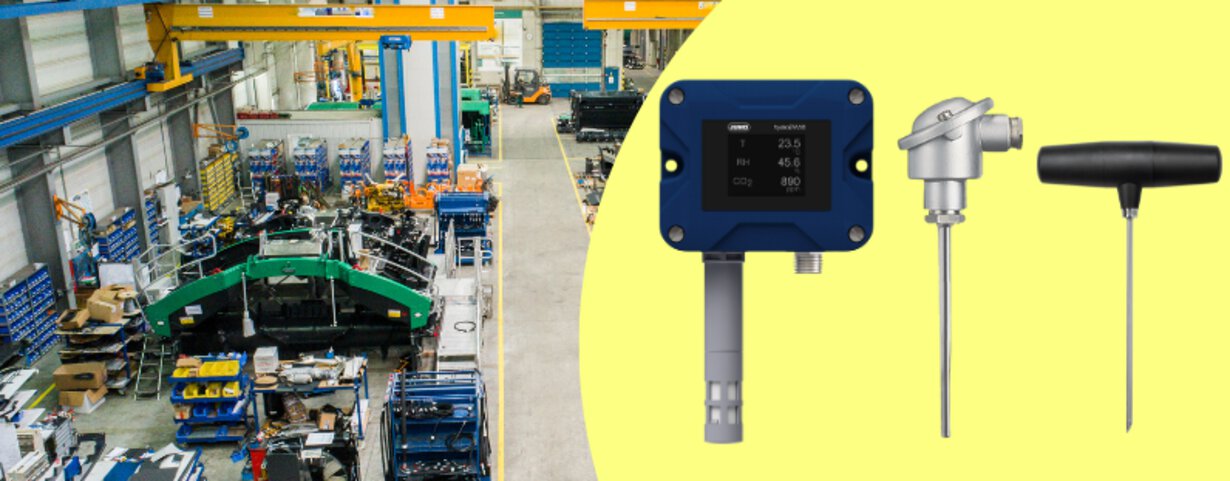
Temperature monitoring in the production hall – an overview of measurement solutions
In every production hall, temperature directly affects the quality of processes, the durability of machines, and the comfort of workers. Excessively high temperatures can accelerate equipment wear, while excessively low temperatures can negatively affect the quality of the finished product. Precise temperature monitoring is therefore essential, especially in facilities subject to industry standards such as BRC, HACCP, or GMP. In this article, we will show you how to design an effective temperature measurement system, from sensors to remote data analysis. Read on!
Wired Pt100 and PT1000 resistance sensors for production halls
In production halls, where working conditions can be demanding, wired resistance sensors such as Pt100 or Pt1000 are most commonly used. This solution works well wherever long-term measurement stability, resistance to interference, and accuracy over a wide temperature range are important. These sensors can be installed in various locations: on walls, ceilings, in ventilation ducts, or directly in process installations.
Our product range includes resistive sensors designed for such applications. Models with IP65 enclosures are resistant to dust, moisture, and typical industrial environments. Various mounting options are available, making it easy to adapt the device to a specific location in the hall, whether it is a fixed measuring point in a control cabinet or temperature monitoring directly on the production line.
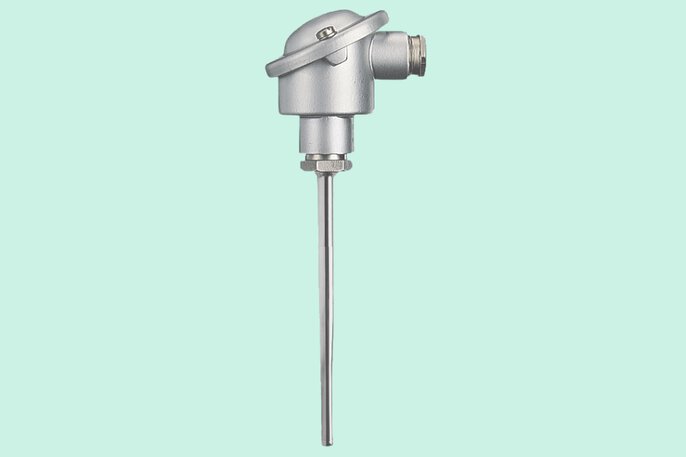
Screw-in resistive temperature sensor with type B head (902020)
Wireless temperature sensors for use in production halls
In some production halls, installing wired sensors can be difficult or costly, especially in large spaces or areas with limited access. In such situations, wireless measurement systems are a good solution. They enable quick implementation of measurement points without the need for cable installation, and data can be transmitted in real time to the monitoring system.
Wireless temperature measurements are used, among other things, to monitor conditions in hard-to-reach areas of the hall, near moving parts of production lines, and in areas where it is physically impossible to run cables, e.g., due to sanitary conditions or explosion safety.
The JUMO Wtrans series is well suited for such applications. These wireless temperature transmitters communicate in the 868 MHz band at a distance of up to 300 meters. The sensors can be used both stationary and mobile, e.g., for temporary measurements in a newly constructed part of a hall or for testing purposes. Versions approved for use in potentially explosive atmospheres (ATEX) are also available, further expanding the range of possible applications.
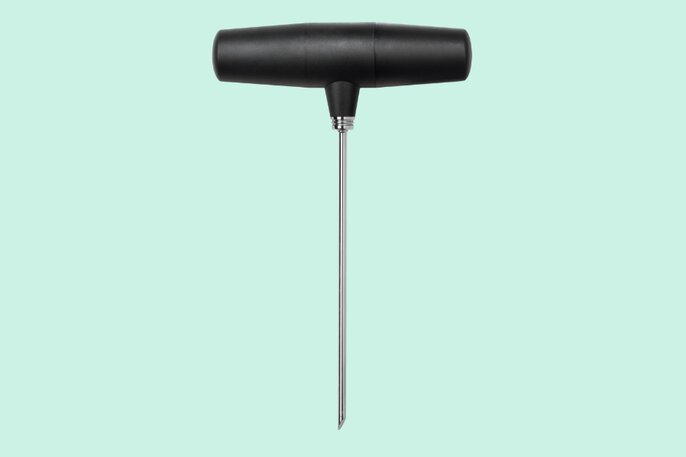
JUMO Wtrans T wireless temperature sensor (902930)
Integrated temperature and humidity measurement in production halls
In production halls, precise monitoring of the microclimate has a direct impact on the stability of technological processes, employee safety, and the quality of final products. In places where not only temperature control is important, but also humidity and CO₂ concentration, multisensors, i.e., sensors combining several measurement functions in one device, work best.
The JUMO hydroTRANS series has been designed with these requirements in mind. The S20 model is wall-mounted and used in workspaces, while the S30 version is designed for ventilation ducts, where precise monitoring of the air supplied to or extracted from the hall is important.
These devices enable simultaneous measurement of temperature and relative humidity and, if necessary, carbon dioxide concentration. Depending on the configuration, data can be transmitted in analog form, for example as a 4–20 mA or 0–10 V signal, or digitally using the Modbus RTU protocol. The latest versions also feature Single Pair Ethernet communication, which simplifies integration with industrial automation systems and eliminates the need for multiple cables.
HydroTRANS sensors are distinguished by their high accuracy, fast response time, and repeatability of measurements. This allows for early detection of deviations, such as increased humidity or local overheating, before they begin to affect production continuity or the quality of the final product. This makes it possible to maintain stable environmental conditions in the hall, which is particularly important in industries requiring high quality control, such as the food, pharmaceutical, and electronics industries.
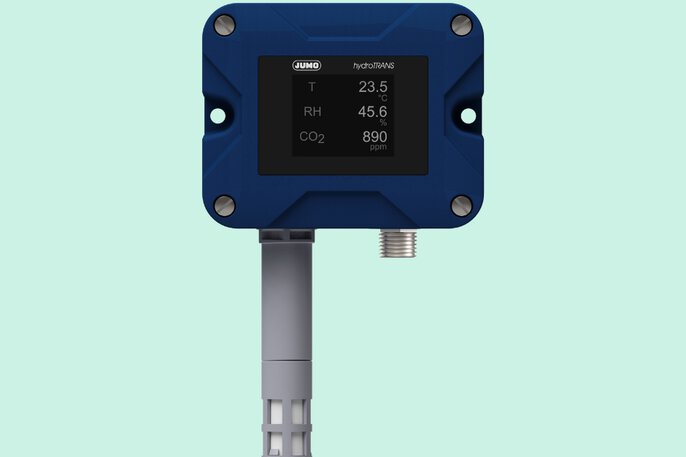
Humidity and temperature transducer with optional CO2 module in wall-mounted version JUMO hydroTRANS S20 (907042)
Automation of production hall condition monitoring using SCADA and Cloud
The JUMO variTRON system (versions 300 and 500) acts as the central control unit for the entire measurement system in the production hall. It enables simultaneous collection of data from multiple sensors – temperature, humidity, CO₂ – in real time and active control of HVAC systems based on current readings. The platform also offers data logging, alarm management, and reporting functions. The entire system can be integrated with smartWARE SCADA software and the JUMO Cloud platform, allowing remote access to the system via a web browser. Users can visualize temperatures in different rooms, analyze trends, and configure email and SMS alarms in case of threshold exceedances. This solution ensures constant monitoring of environmental conditions in the hall, supports quality documentation, and allows for the optimization of technological processes.
About the author
My name is Ewelina Szmit and I have been working in content marketing for several years, combining my professional skills with my passion for writing. I am convinced that even the most technical topics can be presented in an interesting and accessible way. Outside of work, I express my creativity by creating collages from newspaper clippings. I like to spend my free time actively, walking my dog or running.

Technical Specialist
Jakub Dąbrowski - Internal Sales Engineer +48882351471 Jakub.Dabrowski@JUMO.net +48882351471Comments
We encourage you to leave comments using the form below. They will be published online after they have been approved by our verification process.

